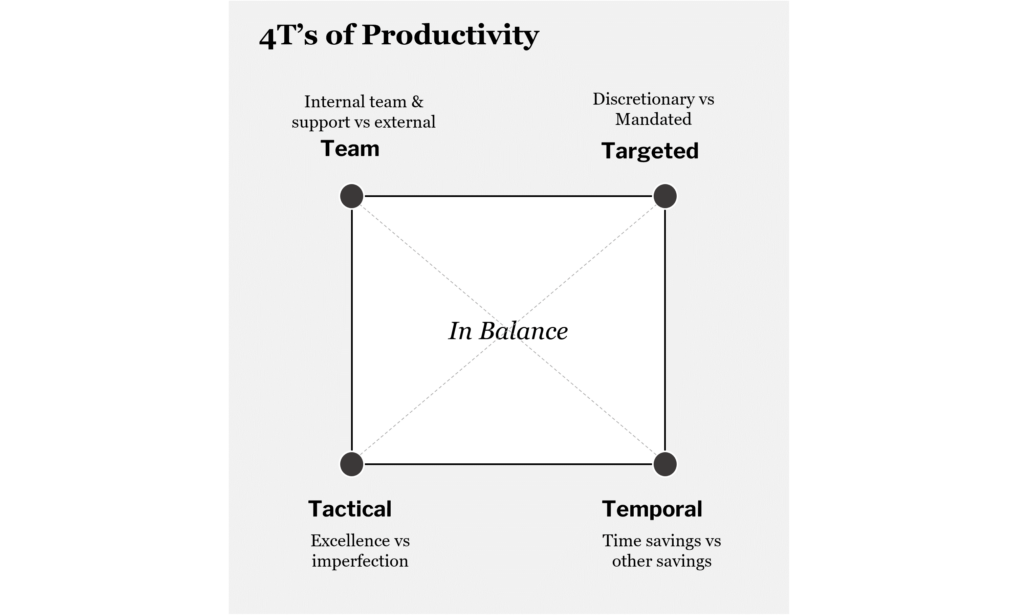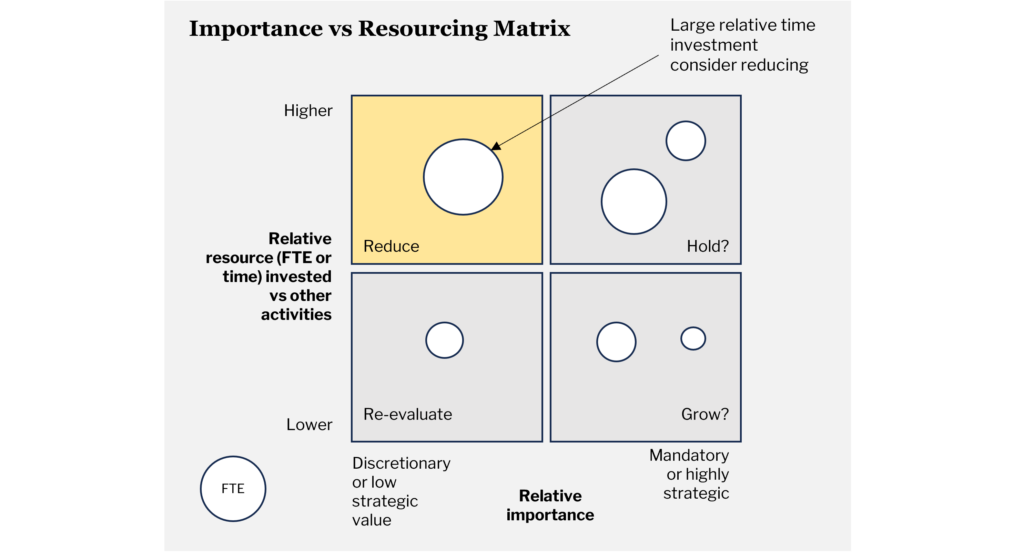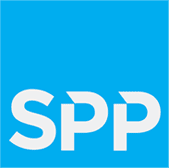Insights
Productivity – Finding The Balance


The four “T’s” that drive successful productivity programs
Key Take-aways
Four key elements can drive the success of a productivity program if kept in balance
- Team based approaches that use internal team members with strong sponsorship can drive longer term success
- Targeted portfolios that attack discretionary time or time that is out of balance, and which take greater care around “must do” or mandated activity work well
- Tactical approaches – small projects, small to medium wins – can often be as useful as bigger projects
- Temporal (time based) savings, and a focus on effort rather than dollars, can yield significant results
Background
Quite some years ago we published an article on setting up productivity programs for success. It’s interesting looking back on our experience over the past 18 years, and the things that we have learned – some of which validate those original findings. We’ve continued to discover approaches that can help.
The thoughts below are based on improvement programs across a variety of industry sectors and business types. Some of these projects have been a success, and some have been unsuccessful. Some are focused on cost, some on organisational efficiency, and some simply on reducing noise and chaos to get a better result for the customer or stakeholder. Looking back, we have identified some of the things you need to get right, to make these programs work.
The Four T’s for success
Four separate elements that drive success, consistently come up. I like to think of this as finding the balance– that is, getting the mix across these four areas right. If any single element is “out of balance” – the program has a diminished chance of success.

Team Driven – doing it for yourself, to yourself
Ownership has been the #1 driver of success in all of the programs of business improvement and productivity push that we have worked on in recent times. Getting internal teams behind the objective, and then working together in concert to deliver a result, has either made or destroyed the program.
Having a strong senior sponsor who works closely with a transformation lead, is fundamental. In addition, having a deeply held, outwardly communicated belief that internal team members can gain the skills needed to drive an efficiency program, is also critical – and this can be done, as long as appropriate training and guidance is provided.
Considerable momentum can be gained by having a strong internal team on board. The counter-weight to this, is the time it takes to get that team up to speed. This is where some short term resource – a specialist contractor or consulting team – can sometimes get a program established and moving, without waiting for the full investment in an internal team to bear fruit.
Case Study –
Supporting Government with an internally-focused productivity drive.
The client organisation embarked on a productivity improvement program which was heavily internally driven. Team members were assigned based on both their experience and capability, and received training from SPP in improvement techniques. Strong initiative ownership was assigned to initiative leads, with visible leadership of the program from Senior Executives.
SPP’s team made up less than 1:10 of overall program FTE.
The project delivered an efficiency gain of 15% of all effort or time spent, within a 6 month project timeframe, and was nominated for an award. The return was approximately 10x on investment.
Targeted – importance to the customer vs discretionary
Most teams – public or private – have a core customer outcome they must deliver at a mandated or even regulated level. This is the case across Government, Financial Services, and even in some instances in Education. Being clear on a minimum service requirement, and the balance of resource invested in this effort, can be a really useful starting point for a productivity program – identifying where the investment is a “must do”.
In our experience, working through this early in the process has allowed a greater focus to be placed on discretionary effort where the risk of getting it wrong is somewhat lower. In addition, it has also sharpened the approach to delivery on mandated activities – where the focus is just as much on effectiveness of delivery, as it is on efficiency.
A simple exercise involves mapping organisational “effort” on a 2×2 as shown below – with the relative importance of an activity on one axis, and relative effort on the other. Each activity or group of activities are mapped against these dimensions. Attacking high-importance (mandatory) activity, where that activity is already getting a relatively low investment, for example, would be a waste of time. However, over-investment even in mandatory activity, can be highlighted as an area for potential intervention.

Finally, understanding where time goes is useful – especially in service-based organisations. An approach we have used regularly is to start by understanding a simple breakdown of activity in the organisation – and from there, to use a simple process of estimation to identify how much time goes into each activity area. Despite its imperfections – this can provide a simple path to the baseline-pools of activity that might, with improvement, result in significant savings.
Ultimately – customer impact from a productivity drive does not need to be negative. Working through processes such as these can be helpful in avoiding the trap of savings that come with a poor outcome.
Tactical – make imperfection your friend
Many productivity programs seek to do a broad sweep through an organisation, and result in long, complex lists of improvement initiatives that can be difficult or even infeasible to take on due to their complexity or volume.
Our view, and experience, has been that doing less, and doing it well, can outperform larger scale transformation. Part of this mindset of imperfection (for more, see R.McLean “The Imperfectionsts”) is to encourage a different way of thinking about improvement:
- Yes – think digital – but don’t always try to deliver every improvement through a full end to end digital improvement process – looking for a diverse range of solutions (e.g. things to stop doing, pause doing) can be just as effective;
- Small wins are still good wins – they accumulate to some relief for teams, and a reduction in cost if managed carefully to completion; and
- It can be equally useful to finish a set of small to medium projects and bank some benefit than risk everything on a longer term (2yr plus) program of transformation.
Building the organisational transformation muscle through a series of smaller projects can deliver shorter-term gains, and take at least some of the pressure off a large scale annual target.
Temporal – win back some time
The final element we’ve seen succeed is a focus on time-based savings. That is not to say, that re-organising or re-structuring cannot yield savings – it can. But for service-based organisations particularly, a keen focus on winning back time and converting that into either savings, or more value-adding activity, has been a strong precursor to success.
This involves looking at every saving with “effort” or time as a key unit of measure. In fact, with one client, the entire project shifted from discussing dollar-based savings, to effort-based savings. Most people in the organisation stayed focused and engaged on winning back minutes, hours, and days, to enable the organisation to continue to scale due to an increase in demand for their services.
Other cost-saving measures are still valid of course – particularly in larger organisations. Re-organisation, procurement, salary/EBA negotiations, offshoring, outsourcing, AI and RPA can all potentially deliver savings and cannot be discounted.
However, we’ve found that too often, organisations fall into the trap of going straight to a number of these options, particularly re-organisation, without looking directly at the nature of the work itself, and ways in which it can still effectively (but more efficiently) be delivered.
Conclusions
For an organisation looking to find productivity gains we’ve suggested a few approaches that can really help set the organisation up for success. We wish you the best on your business improvement project journey, and would be happy to chat further about these techniques.
Summary – the 4T’s of successful productivity programs
| Team driven | Get sponsorship in place, and a good senior leader – provide training, and get support externally where you need additional expertise and capacity |
| Targeted | Make sure you are clear on the discretionary vs the mandated. Be clear also on where effort or activity lies. |
| Tactical | Be OK with imperfection. Don’t build the transformation program you don’t need. Smaller to mid size wins can be good – even those that do not require IT investment. |
| Temporal | Make sure you keep time-savings at the forefront of your investment in productivity. Re-organisation, procurement, and RPA can all create large wins but typically take longer and can sometimes have negative consequences. |
Key Contacts
Phil Noble / Founder and Managing Partner
Phil Noble is the Founder and Managing Partner of SPP. He is an experienced General Manager, Consultant and Entrepreneur and has worked in a wide range of industries including financial services, telecommunications, infrastructure and Not for Profit. Phil has...
Connect on email
Connect on LinkedIn
Tim McMaster / Partner
Tim McMaster is a Partner in SPP’s Sydney office with over 20 years experience with capabilities largely centred around three key areas:1) Leading strategic and business transformation projects.2) Identifying new service delivery models and target operating models for improved...
Connect on email
Connect on LinkedIn


